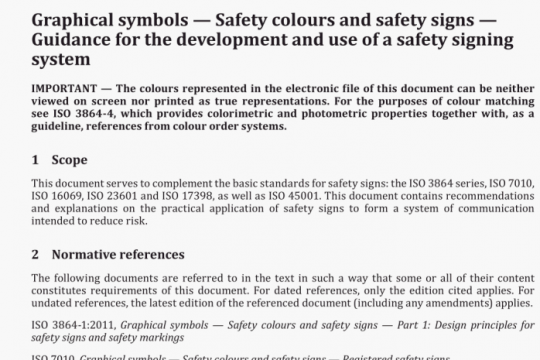ISO/TS 22292 pdf free download
ISO/TS 22292-2021 pdf free download.Nanotechnologies – 3D image reconstruction of rod-supported nano- objects using transmission electron microscopy.
The acceleration voltage shall be selected as described in A.2.4 d) on sample thickness. Typically, 300 kV or 200 kV should be used.
Using the maximum voltage available on a particular TEM is preferred. Using the maximum available voltage means maximum allowable sample rod diameter and maximum depth of focus. For example, using 300 kV rather than 200 kV allows for 250 nm diameter carbon rod rather than 200 nm diameter rod at 200 kV.
5.1.3 Convergence semi-angle
The convergence semi-angle shall be selected so that the illumination at the sample plane is uniform over the imaged area of the sample. Furthermore, the illumination uniformity has to be such that the apparent sample focus does not visibly change over the observed area.
NOTE The illumination uniformity can be verified by performing an intensity profile across the image (e.g. diagonally from corner to corner of the image). The uniformity of the defocus value is typically not a concern and it can be verified by performing a fast Fourier transform (FFT) of sub areas of the image. For example, a 2048 x 2048 image can be divided into 256 x 256 pixels regions of interest. The image composed of absolute value of FFT can be compared among the various regions of interest to ensure that the FFT does not vary too much from region to region. An FFT that has same numbers ofcircular rings over an arbitrary sub-field ofview is an indication that illumination is sufficiently uniform.
5.1.4 Collection angle
In conventional TEM mode the collection angle is selected by the objective aperture size. The collection angle is determined as the square root of the sum of squares of the convergence angle and acceptance angle of the objective aperture. In practise the convergence angle in TEM mode is much smaller than the acceptance angle of the objective aperture. Therefore, the collection angle is determined by the objective aperture acceptance angle alone.
The main criteria for collection angle is the avoidance of diffraction contrast while maximizing the contrast in the image. The contrast increases with decreasing collection angle,L9iL1i but at the same time, the diffraction contrast increases with decreasing collection angle. The presence of diffraction contrast could make the data unsuitable for 3D reconstruction.l2lI1l The number ofcounts collected by the detector decreases with decreasing collection angle leading to increase in acquisition time.
5.1.5 Microscope magnification
Microscope magnification and detector pixel size are critical parameters to ensure correct sampling of the object for 3D reconstruction. The higher the desired number sampling, the lower the effect of the detector point spread function. At the same time high sampling, i.e. high microscope magnification and small pixel size, decreases the field ofview that can be acquired without region stitching by subsequent offset acquisitions. High magnification also decreases the number of counts per pixel at a given beam current density and acquisition time. Typically, the magnification is chosen so that the desired projected image resolution is sampled by 5 pixels or moreU-1l.
EXAMPLE ifa desired projected image resolution is 1 nm, the pixel size is chosen to be about 0,2 nm. A 2 048 pixel x 2 048 pixel camera can then cover a 410 nm x 410 nm field of view that is adequate for most practical purposes. For example, a camera with physical 5 i.im x 5 tm pixel size and 0,2 nm pixel size at the sample plane requires microscope magnification 25,000x. Typically, a somewhat higher magnification, for example, 30,000x, can be chosen to slightly oversample the object.
5.1.6 Number ofpixels ofthe detector
The highest number of pixels on the camera should be used to achieve optimum image resolutEon and field ofview. For example, it is advisable to use binning 1 for a 2 048 pixel x 2 048 pixel camera so that there are 2 048 pixel x 2 048 pixel in the images. Number of pixels, their size, the field of view and the image resolution are related. See 5.1.5 for an example of magnification estimate.
If the point spread function of the camera is poor, it can be necessary to combine camera pixels (bin the pixels). In such case, the necessary magnification should be estimated for the combined pixel size. Combining (binning) the camera pixels results in a corresponding decrease of the field of view as compared to binning 1 images. For example, a 1 000 nm2 x 1 000 nm2 field ofview with 0,5 nm per pixel obtainable with 1 000 pixel x 1 000 pixel2 camera would be reduced to 500 nm x 500 nm ifthe camera is binned by 2 while maintaining sampling 0,5 nm per pixel.
5.1.7 Image acquisition time
Image acquisition time shall be chosen such that enough signal to noise ratio is obtained in the projected images to allow for projected image alignment and for reconstruction. The acquisition time needs to be chosen such that the sample drift is less than the pixel size at the sample plane. lfthe number of counts per pixel is too low at the drift limited acquisition time, either the microscope beam current can be increased or multiple images at each tilt can be acquired. Typically, about 100 electrons per pixel of the detector are sufficient for alignment and reconstructionlUl.
5.2 Microscope calibration
To ensure correct microscope calibration, the microscope shall be calibrated under the same imaging conditions as used for the tomography data acquisition. The calibration shall be performed either immediately before or immediately after the data acquisition. Identical conditions in this case refers to using the same lens currents, the objective lens and the intermediate and projector lens system currents, as used for the tomography data acquisition. The calibration of the TEM instrument shall be performed as described in ISO 21363.
NOTE Calibrating before or after collection of projected images is equivalent as long as the lens settings are not changed between calibration and collection of projected images.
For precise size measurement by using TEM, the same condition of TEM lens and specimen height between a measurement specimen and a calibration specimen is important. An internal reference length for TEM instruments must be calibrated using calibration standards. All size measurements should be done with the same lens and specimen height conditions of calibration. Focusing condition of the lens can affect the size measurement. A Scherzer defocus condition is generally used. The zero defocus is defined using Fresnel fringe at first, then focusing goes to Scherzer defocus. Specimen height should be at the eucentric position. it is important to obtain images at eucentric height and the same defocus condition at magnifications as used explicitly for the instrument’s calibration.
For most microscopes the selection of identical conditions is achieved by selecting the same nominal magnification and same focus value of the objective lens current as used for the tilt series acquisition. The sample focusing shall be achieved by utilizing the mechanical Z height of the stage. Focusing by changing the imaging lens in a TEM or probe forming lens in STEM should be limited to a range no more than ±1 pm to prevent magnification change or image rotation. The lens currents must be same for microscope calibration as for data collection. Calibration should be performed at the eucentric height and at the limits of the range of lens current focusing. For calibration a suitable calibration sample with known dimensions shall be used. An example of such sample is available from several suppliersIi.
The pixel size obtained using the above calibration procedure shall be used to calibrate the reconstructed 3D volume.
See Annex D for recommended microscope and data collection parameters to record. See Annex H for an example of uncertainty budget.ISO/TS 22292 pdf download.




